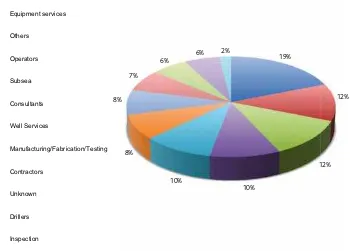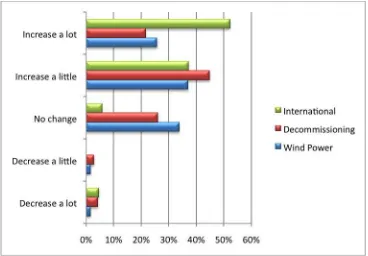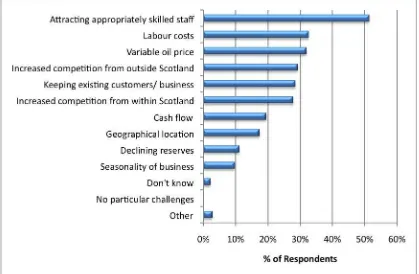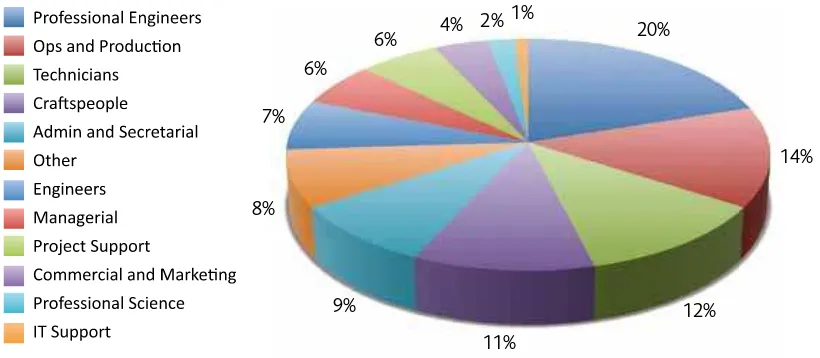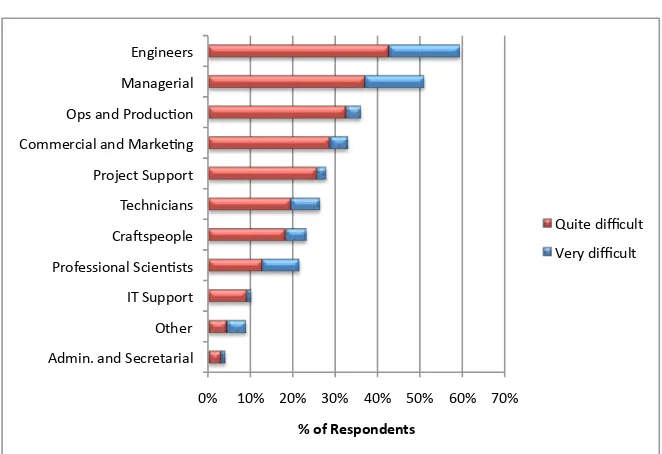Summary Report
March 2011
Report produced by
Table of Contents ... 1
Foreword – OpiTO ... 2
Foreword – Skills Development Scotland ... 3
Executive Summary... 4
introduction and Context ... 6
Oil and Gas – Employment Growth ... 7
Mixed impact of Recession ... 9
The pressures of Diversiication ... 11
The Labour Market – The primary Challenge for the industry ... 13
Recruitment and Retention Dificulties ... 15
Qualiications – Satisfaction and Supply ... 18
Ongoing and Resolving Demographic issues ... 19
Training – Satisfaction and Motivation ... 22
Conclusions ... 23
Foreword:
OPITO
The enclosed survey, conducted by the Centre for International Labour Market Studies at Robert Gordon University on behalf of OPITO and Skills Development Scotland (SDS) illustrates and provides tangible evidence of the optimistic trends we have seen building in the Oil and Gas Industry through 2010. Indeed, the indings are consistent with other recent research conducted by the Aberdeen & Grampian Chamber of Commerce and the ECITB.
Although there is heartening evidence that many companies have chosen to retain and grow their indigenous talent, even through a period of economic downturn, the next ive years will be a period of growth and it is clear that attracting, retaining and developing the right skills is essential if the planned projects and developments are to be realised. The survey provides us with an insight into the key skills issues the UK industry faces as it gears up for growth. This must be regarded in the wider context of increased global activity, a growing UK power and renewable sector, constraints to imported labour and unprecedented public sector funding cuts which, added together, serve to
generate ever increasing competition for talent. The survey provides a quantitative measure of the opportunities, needs and challenges facing the industry. This information gives us in OPITO conidence that the many projects and services we currently run are on the right track. However, it does illustrate that much more needs to be done if the quality and quantity of skilled people, in particular from the UK education and training ‘system’, is capable of meeting the growing demand.
2011 will see us launch a number of signiicant additional interventions as a result:
• Increased attraction through the Next Generation project • Oil and Gas speciics into the education curriculum
through the Petrochallenge project – targeting every school in Scotland in 2011
• Up-skilling from other industries/regions under our transformation program
Foreword:
Skills Development Scotland
The energy sector is one of Scotland’s key economic drivers. As we continue to beneit from continued development and investment within the oil and gas sector, there is also recognition that there are signiicant opportunities as the demand for renewable energy grows and new technologies emerge to support the low-carbon economy.
Skills Development Scotland recognises that effective collaboration with key stakeholders such as OPITO is required if Scotland is to fully capitalise on these developments, and to produce a workforce with the skills and capability to exploit these opportunities and deliver sustainable economic growth.
There is evidence of emerging skills shortages within many areas, and the sector faces signiicant new challenges. Add to this the demand for replacement labour and skills and the increasing competition for new entrants, and the need for a more robust and informed sector skills strategy becomes more apparent.
OPITO Executive Summary
The key indings of the survey are:
• The future looks optimistic. 81 per cent of companies who responded expect their business to grow over the next ive years and 44 per cent predict growth in the size of their workforce in 2011.
• During 2010 – and under considerable economic downturn – the respondents (144 companies) offered over 2,000 vacancies. As our respondent companies are responsible for employing around 67,000 of an estimated 400,000 total employees in the UK oil and gas industry, it is clear that the number of vacancies across the industry is likely to be signiicantly higher. This may indicate that in aggregate, the industry is preparing for growth and replenishing skills. • At the time of conducting the survey (second half of
2010), the majority of respondents anticipated further growth in their workforce: 12 per cent of companies expect to grow by more than 50 people in the next twelve months, and 5 per cent of companies expect growth of over 200 people in the same period. • Although many parts of the industry sought to recruit
in 2010, a third of respondents cut their workforce numbers. The drilling, manufacturing and fabrication sectors suffered most from this. Reduced exploration activity and lack of visibility of future project development for those sectors could explain a short-term reactive approach.
• Very few companies have increased their reliance on contract or more lexible labour, which indicates a drive to retain and maximise eficiencies from their core skills and experience. This seems particularly important as the industry moves into a period of growth and project development.
• Not surprisingly, growth – and hence skills demand – is being led by operators, contractors and the subsea sector, which relects the nature of project development in the North Sea. The strongest growth expectations in the medium-term (ive years) are seen in companies employing over 500 people. However, short-term growth (one year) is seen as most likely in companies employing fewer than 500 people. This could be illustrative of an ability on the part of smaller companies to better react to the demands of the market, and provides a lens through which to prioritise effort to address skills needs.
• Respondents provided clear evidence that inter-company competition for skilled, experienced workers is increasing. Historically this has resulted in a culture of wage inlation and loss of skills continuity. With increasing demand for experience and skills in the short and medium term, this clearly points to an urgent need to increase the experienced talent pool through mechanisms such as bespoke training provision, transformation programmes and attraction of relevant skills from other energy sectors.
• Competition from other industry sectors is increasing; particularly from other energy sectors. Over the next ive years, respondents are expecting a considerable increase in activity in international work and, to a lesser extent, in decommissioning and wind power. Indeed, our indings suggest that other energy sectors are already attracting talent from the oil and gas industry. • The most dificult vacancies to ill are those for
engineers, professional engineers and managers. This dificulty is compounded by the fact that the skills, knowledge and experience lost through retirement are more dificult to replace in these areas than is the case for other workforce areas. Furthermore, it is also important to note that the average proportion of managerial staff approaching retirement age is considerably larger than in other workforce areas. • With the exception of managers, the industry appears
to have taken steps to address the problems it previously faced in relation to an ageing workforce. In some workforce areas, a sizeable proportion of employees are aged 16-25. Whilst this injection of younger talent has redressed the age proile, it could also help to explain the increased need for experience. This is a particular problem given that the industry is gearing up for growth, and reinforces the need for effective Knowledge Transfer mechanisms
between experienced and inexperienced employees, particularly in areas such as engineering.
• With the exception of administration and secretarial functions, women are under-represented throughout the industry compared with many other UK private sector companies (41 per cent across the UK’s private sector companies and 65 per cent in the public sector workforce). Whilst this does not provide a comparison with other engineering-dominated industries, it does indicate that other industries are better able to tap into the increased talent pool. Widening the pool of talent available to the industry will be essential if the recruitment dificulties identiied here are to be addressed.
• Most respondents provide their employees with 1-5 days training per year. Respondents were generally satisied with most aspects of training provision. However, access to funding and more cost-effective, tailored and local provision would encourage companies to take up more training.
Introduction and Context
The Centre for International Labour Market Studies at Robert Gordon University was commissioned by OPITO to undertake a quantitative employment and skills foresight analysis for the oil and gas industry. The study was sponsored by Skills Development Scotland as part of a wider study to capture a demographic proile and skills ‘health check’ of the Oil & Gas, Renewable and Carbon Capture & Storage Industries.
The output from this report together with those from the other two sector studies will inform and guide strategy development of the Government’s Industry Advisory Board chaired by the First Minister, Alex Salmond.
While uncertainty in the inancial markets during 2010 continued to impact business conidence in many industry sectors, the Oil & Gas sector enjoyed relative stability underpinned by a sustained (and increasing) oil price and a consistent growth in worldwide demand for energy During the data collection period, the weekly price of UK Brent Blend luctuated between a low of around $74 and a high of around $84 (US Energy Information Administration, 2010).
It was against this backdrop that OPITO undertook an initial piece of research (during May to July 2010) to develop a
proile of Industry activity & investment over the next 3 to 5 years, from which we could then identify the underlying implications for skills and labour supply/demand.
This report comprises the analysis and output from a survey of companies involved in the oil and gas industry. Data was gathered during August and September of 2010 using a combination of online and paper surveys. Approximately 400 companies were approached to participate in the study.
144 responses were received. The companies who responded are responsible for employing over 67,000 salaried staff and contractors. Contrast this with Oil & Gas UK’s estimate that around 81,000 jobs in the north east of Scotland are provided either directly by the industry or via its supply chain (Aberdeen City & Shire Economic Forum, 2007), and we believe that our survey provides a representative snapshot of the industry as a whole in the UKCS.
As a truly internationalised industry, it could be assumed that the oil and gas industry would be subject to the same external inancial pressures as other industries as a result of the global inancial downturn from 2007 onwards. Indeed, the dramatic fall in the price of crude oil and the slump in natural gas prices in 2008/09 demonstrated that the industry was not immune to such externalities. However,
Oil and Gas - Employment Growth
despite the fact that the past 12 months have been a period of signiicant global inancial instability, the respondents to our survey have remained active in terms of recruitment, offering vacancies for almost 2,000 salaried staff members. Given that they are responsible for employing in excess of 67,000 salaried staff and contractors, this is equivalent to 3 per cent of their total workforce.
Table 1: Breakdown of Respondent Companies by Industry Sector
Equipment services
Others
Operators
Subsea
Consultants
Well Services
Manufacturing/Fabrication/Testing
Contractors
Unknown
Drillers
Inspection
19%
12%
12%
10% 10%
8% 8%
7% 6%
6% 2%
In addition, respondents appear to be optimistic about the prospects for company growth and ongoing recruitment over the short to medium term. A very strong majority of respondents (81 per cent) expect that their company will grow over the next ive years. In addition to this medium term conidence, there is also a large minority
Table 2: Company Expected to Grow over Next Five Years
Strongly agree
Agree
Neither nor
Disagree
Strongly disagree
23%
58%
14%
2% 3%
A number of key industry sectors appear more conident of short-term growth than others. In particular, at least half of all respondents in the subsea, operators and contractors sectors foresee the size of their workforce increasing over the next year. By contrast, no companies in the inspection sector and only 13 per cent of those in the drillers sector predicted any increase. Predictions for ive year growth were particularly conident in the operators, contractors, well services and subsea sectors.
In addition, we found that short-term growth looks likely to be most prevalent among smaller companies in the industry: the proportion of SMEs who predict a growth in the size of their workforce was double that of larger employers.
Analysis of our results shows that many companies are predicting a modest increase in the size of their workforce over the next year, with 38 per cent of respondents predicting an increase of just 1-5 people and 33 per cent
predicting an increase of 6-10 people. However, some companies are clearly keen to increase even more than this, with 12 per cent of respondents predicting that the size of their workforce will increase by more than 50 people over the next 12 months and 5 per cent of respondents stating that they will be recruiting more than 200 people over the coming year. As such, demand for suitably skilled and qualiied candidates is likely to remain high.
Mixed Impact of Recession
The recession has impacted upon companies in different ways. Firstly, there appears to be a difference in terms of the inancial crisis’ impact upon industry sectors and speciic companies. Secondly, companies have responded to these dificulties in different ways.
Just over one third of our respondents (36 per cent) believe that their company sector has been affected by the inancial crisis. However, certain sectors seem to have been hit harder than others: respondents in the operators, contractors, inspection and manufacturing/fabrication/ testing sectors were notably more likely to state that their sector has been affected, whilst the opposite was true for the drillers, subsea and equipment services sectors. In contrast, 44 per cent believe that their own company has been signiicantly affected by the inancial crisis. The impact has been most strongly felt in the supply chain, with a clear majority of respondents in the manufacturing/ fabrication/testing sector (78 per cent) stating that they had been signiicantly affected, although a large proportion of drillers (60 per cent) and companies in the subsea sector (58 per cent) also stated that their company had been affected signiicantly. Interestingly, although they were most likely to state that their sector had been affected, the operators and contractors who responded to our survey were among the least likely of all respondents to state that their company speciically had been signiicantly affected. This apparent conlict between companies stating that their sector has been affected but their company has not (and
vice versa) strongly suggests that in addition to there being a differential impact of the recession between sectors, there is also a very clear differential impact between companies within sectors.
Table 3: Company Response to Financial Dificulties
Our results show that there has not been a uniform effect of the recession, either across or within sectors. As a result, any assistance to help companies through the recession will also need to take account of their unique circumstances rather than being based around a generic, one-size-its-all model.
The Pressures of Diversiication
Table 4: International / Decommissioning / Wind Power Activity Next Five Years
Over the next ive years, respondents are expecting a considerable increase in activity in international work, decommissioning and wind power. 90 per cent of all respondents believe that their international activity will increase, 67 per cent believe that their decommissioning activity will increase and 63 per cent believe that their activity in relation to wind power will increase.
In addition, certain industry sectors appear more likely than others to see their activity in these areas increase a lot. In relation to international activity, at least half of companies in the well services, subsea, inspection, consultants and other sectors expect their activity to increase a lot. The same is true of companies in the contractors, well services and inspection sectors in relation to decommissioning activity. Finally, a relatively large proportion of companies in the subsea, manufacturing/fabrication/testing, consultants and particularly the inspection sector believe that their activity will increase a lot in relation to wind power.
Given that small and medium sized companies are less likely to have the staff resources required to simply be able to move existing staff into new areas, it is very likely that any increase in these areas of activity will be dependent upon an increased supply of suitably skilled and experienced staff. If this is not the case, then better use of existing skillsets (as discussed above) will become ever more important. Either way, smaller companies will require support to develop their work in these areas.
The Labour Market
We asked companies to identify the greatest challenges facing their company over the next year. The greatest concern identiied by respondents was their ability to attract appropriately skilled staff: just over half of all respondents (51 per cent) selected this as a challenge. This was seen as a problem by an above average proportion of companies in the operators, contractors, subsea, equipment services and manufacturing/fabrication/testing sectors, showing that this is a problem which affects virtually the entire industry.
Secondly, and perhaps as a relection of the long-standing issue of wage inlation in the industry, the next most frequently identiied problem overall was labour costs in the industry (33 per cent). Again, this was a problem that affected companies across virtually the entire industry, most notably those in the operators, subsea, inspection, manufacturing/fabrication/testing and consultants sectors.
The Primary Challenge for the Industry
Interestingly, the problem of increased competition was seen as a problem by a particularly large proportion of companies with 251-500 employees. We suggest that this may be relective of their key role in driving short-term growth: as a result, it is perhaps unsurprising that these companies are also the ones most likely to identify an increase in competition both from inside and outside Scotland.
Recruitment and Retention Dificulties
We asked companies to tell us about trends in recruitment. In particular, we asked about how many vacancies they had had in a number of key operational areas over the past year, which of these they ind dificult to ill, and why this is the case. As well as recruiting staff, we asked companies to tell us about dificulties they faced in relation to retaining staff.
Vacancies: Engineers in High Demand
The vacancy pattern of the last 12 months suggests that there has been a very high level of demand for professional engineers. However, skilled manual employees were also in
relatively high demand: there has been a large number of vacancies for operations and production staff, technicians and craftspeople.
It seems clear that whilst the industry is strongly dependent upon a plentiful supply of employees with higher education qualiications, it also remains important to focus on providing a plentiful supply of employees with more vocationally focussed qualiications or apprenticeships.
Table 6: Workforce Vacancies Last Year
20%
14%
12%
11%
9%
8%
7%
6%
6%
4% 2%
1%
Principal dificulty: illing vacancies
dependent upon high levels of
experience and/or qualiications
Our results showed that with the exception of the
inspection sector, a sizable proportion of companies in each industry sector struggles to ill vacancies for managerial staff. Similarly, a large proportion of respondents has dificulty illing vacancies for engineers and professional engineers. These three job roles were the only ones
that wage inlation remains a problem within the industry and that the high demand for and low supply of suitably skilled and experienced candidates leaves some companies struggling to compete inancially.
The labour market has already been shown to be the primary challenge facing the industry. These indings – along with the consistency of these dificulties across different industry sub-sectors – simply serve to reinforce this conclusion. Without addressing the issues of supply/demand and the resulting symptoms of competition for labour within the Industry and consequent inlationary pressures wage inlation and poaching, companies seeking to grow over the coming years will ind it very dificult to ind the human capital necessary to allow this. There is a particularly large problem in relation to professional engineers. Vacancies for professional engineers are not only the most dificult to ill, but also represent the job role for which there has been the greatest number of vacancies in recent years. As such, the issue of supply and demand is particularly problematic in relation to professional engineers. The lack of qualiied engineers must be addressed in
conjunction with providers of tertiary education (i.e. colleges and universities): whilst there is a clear thirst for a greater number of qualiied engineers, further research should aim to establish whether there is a problem of simply too few engineering graduates or a lack of interest among graduates in relation to careers in the oil and gas industry. Given the dificulties in illing managerial vacancies, there is a clear need for greater thought to be given to the way that aspiring leaders or managers can be developed internally or introduced from other industries.
Why is it dificult to recruit?
The key issue behind recruitment dificulties is that industry demand for suitably skilled and experienced candidates continues to outstrip the supply: a lack of experienced applicants, a lack of skilled applicants and a high level of competition for applicants from other employers were – by some margin – the most common problems faced by the industry as a whole when trying to ill vacancies. The next most common problem – the inancial reward package which could be offered to potential employees – suggests
19
professional scientists, the equipment services sector has particular difficulty recruiting craftspeople and technicians, whilst operators and contractors appear to have difficulty filling vacancies for project support and operations and production staff.
Table 7: Most Difficult-to-Fill Vacancies
The lack of qualified engineers must be addressed in conjunction with providers of tertiary education (i.e. colleges and universities): whilst there is a clear thirst for a greater number of qualified engineers, further research should aim to establish whether there is a problem of simply too few engineering graduates or a lack of interest among graduates in relation to careers in the oil and gas industry. Given the difficulties in filling managerial vacancies, there is a clear need for greater thought to be given to the way that aspiring leaders or managers can be developed internally or introduced from other industries.
Why is it difficult to recruit?
The key issue behind recruitment difficulties is that industry demand for suitably skilled and experienced candidates continues to outstrip the supply: a lack of experienced applicants, a lack of skilled applicants and a high level of competition for applicants from other employers were – by some margin – the most common
Dificulties in retaining staff
As was the case in relation to illing vacancies, our results show that the inancial reward package on offer and competition from other employers for skilled and experienced staff were by far the biggest issues for companies when trying to retain their employees. Anecdotal evidence from the industry would appear to conirm that competition from other employers and the use of inancial reward packages to entice staff from other companies are direct contributors to a culture of wage inlation in the industry. However, despite the short-term appeal of using inancial reward packages to attract staff, rampant wage inlation runs the risk of reducing overall proitability and the economic viability of projects. Ultimately, it does nothing to increase the overall supply of skilled and experienced workers in the industry.
The problems of supply and demand in relation to skilled and experienced employees mean that the labour market is iercely competitive. This is not a new issue and previous growth cycles have
Earlier results showed that companies have to deal with a clear shortage of suitable skills and experience when trying to recruit. Compared to ‘softer’ skills, a smaller proportion of companies identiied dificulties in terms of speciic
Qualiications – Satisfaction and Supply
Respondents reported a very high level of satisfaction with the way that the current portfolio of oil and gas qualiications meets the needs of the industry: 90 per cent of respondents feel the current portfolio of oil and gas qualiications meets their needs. Once again, this suggests that the crucial issue is one of increasing the supply of qualiied applicants rather than materially altering the content of relevant qualiications.
Given that a small – but nonetheless important – minority of respondents either face a shortage of a speciic qualiication or feel that the current portfolio of oil and gas related qualiications do not meet industry need, it is extremely important that education providers and industry representatives establish the areas of weakness or shortfall with a view to addressing any problems at the earliest opportunity. Further research would be helpful in identifying these areas.
qualiication shortages. The most commonly identiied qualiication for which there existed an identiied shortage was irst degrees (15 per cent), followed by postgraduate degrees (13 per cent).
Table 8: Qualiications in Short Supply
21
QUALIFICATIONS – SATISFACTION AND SUPPLY
Earlier results showed that companies have to deal with a clear shortage of suitable skills and experience when trying to recruit. Compared to ‘softer’ skills, a smaller proportion of companies identified difficulties in terms of specific qualification shortages. The most commonly identified qualification for which there existed an identified shortage was first degrees (15 per cent), followed by postgraduate degrees (13 per cent).
Respondents reported a very high level of satisfaction with the way that the current portfolio of oil and gas qualifications meets the needs of the industry: 90 per cent of respondents feel the current portfolio of oil and gas qualifications meets their needs. Once again, this suggests that the crucial issue is one of increasing the supply of qualified applicants rather than materially altering the content of relevant qualifications.
Given that a small – but nonetheless important – minority of respondents either face a shortage of a specific qualification or feel that the current portfolio of oil and gas related qualifications do not meet industry need, it is extremely important that education providers and industry representatives establish the areas of weakness or shortfall with a view to addressing any problems at the earliest opportunity. Further research would be helpful in identifying these areas.
In addition, there is a key role for education providers to play when it comes to incorporating softer and industry-specific skills into the qualifications they offer. Although it is extremely important to identify any ways in which these skills might be
0% 2% 4% 6% 8% 10% 12% 14% 16% 18%
Ongoing and Resolving Demographic Issues
Gender
Analysis of MIST data obtained from OPITO (2010b) has found that female workers make up only 4 per cent of the total offshore oil and gas workforce, despite ONS igures showing that they make up 41 per cent of the UK’s total private sector workforce and 65 per cent of the total public sector workforce (Ofice of National Statistics, 2007). Our
indings are based upon speciic workforce areas, but as with the MIST indings, there is clear evidence of under-representation of women in most of these sectors. The mean percentage of women working in each of the industry sectors we considered passed the national private sector benchmark of 41 per cent in only one sector: administrative and secretarial (52 per cent female).
Table 9: Proportion of Female Employees by Workforce Area
23
ONGOING AND RESOLVING DEMOGRAPHIC ISSUES
Gender
Analysis of MIST data obtained from OPITO (2010b) has found that female workers make up only 4 per cent of the total oil and gas workforce, despite ONS figures showing that they make up 41 per cent of the UK’s total private sector workforce and 65 per cent of the total public sector workforce (Office of National Statistics, 2007). Our findings are based upon specific workforce areas, but as with the MIST findings, there is clear evidence of under-representation of women in most of these sectors. The mean percentage of women working in each of the industry sectors we considered passed the national private sector benchmark of 41 per cent in only one sector: administrative and secretarial (52 per cent female).
At this stage, it is impossible to state how gender affects the likelihood of working in the industry. The industry needs to examine closely whether the problem is a supply-side or a demand-supply-side one: is it simply the case that fewer women want to work in certain job roles (e.g. engineering and crafts), or do companies shy away from hiring women for certain roles?
Some of the professions we considered have traditionally seen an under-representation of women, most notably crafts and engineering (Office for National Statistics, 2008; National Skills Forum, 2009). However, their current low levels of representation are more surprising in sectors such as commercial and marketing (18 per cent), management (15 per cent), Project Support (12 per cent), IT support (10
0% 10% 20% 30% 40% 50% 60%
Cra]s Professional ScienEst Technical Engineering Professional Engineering OperaEons and ProducEon IT Support Project Support Managerial Commercial and MarkeEng Admin. and Secretarial
Age
Despite widespread perceptions of an ageing workforce, our results show that for some areas of the workforce the mean age of workers is considerably lower than in others. The workforce areas which contain the largest proportion of employees approaching retirement age (i.e. aged 56 and above) are managerial staff (16 per cent), operations and production staff (12 per cent), administrative and secretarial staff (11 per cent) and professional engineers (9 per cent).2 In contrast, some workforce areas contain a
particularly large proportion of workers aged 25 or under, most notably craftspeople (20 per cent) and technicians (19 per cent).3
However, there are some job areas which appear to pose a particular problem for the industry in terms of loss of skills, knowledge and experience through retirements. The most prominent of these were engineers, managers and operations and production staff. To deal with this, the most common responses from companies have been to undertake succession planning exercises (34 per cent) or to invest in mentoring schemes (17 per cent). Although 22 per cent of companies state that an ageing workforce is not a problem for them, a considerable proportion of companies seems to be deferring the problem, with 15 per cent seeking simply to retain retired staff and a further 15 per cent offering lexible working for older employees.
1 Figures represent the gender balance of students enrolled in the School of Engineering, School of Computing, School of Pharmacy & Life
Sciences, and Department of Management, 2009/10. Data obtained from the Student Administration Ofice at RGU.
2 Additional work undertaken by OPITO suggests that the proportion of the entire industry workforce aged 56 or over is 12 per cent.
See OPITO (2010a).
3 Additional work undertaken by OPITO suggests that the proportion of the entire industry workforce aged 25 or under is 8 per cent.
See OPITO (2010a).
At this stage, it is impossible to state how gender affects the likelihood of working in the industry. The industry needs to examine closely whether the problem is a supply-side or a demand-side one: is it simply the case that fewer women want to work in certain job roles (e.g. engineering and crafts), or do companies shy away from hiring women for certain roles?
Some of the professions we considered have traditionally seen an under-representation of women, most notably crafts and engineering (Ofice for National Statistics, 2008; National Skills Forum, 2009). However, their current low levels of representation are more surprising in sectors such as commercial and marketing (18 per cent), management (15 per cent), project support (12 per cent), IT support (10 per cent) and professional science (3 per cent).Current enrolment igures at RGU suggest that the reality may incorporate both supply-side and demand-side factors: whilst male undergraduates currently greatly outnumber females on engineering (92% / 8% split) and IT courses (83% / 17% split), females actually outnumber males in science courses (28% / 72% split) and management courses (44% / 56% split).1 The very
brought on board in order to offset the impact of an ageing workforce, it is also important to recognise that such recruits are unlikely to have the full range of skills and experience required. In addition to training, an encouraging proportion of companies have sought to address issues such as this through succession planning and mentoring. However, a considerable proportion of companies still appear to be simply deferring the problem of an ageing workforce, and it will be crucial to engage such companies in future work to address such issues.
Although our results suggest that the age proile of the industry may be lower than was previously the case, it remains important to be aware that a noteworthy minority of employees in some workforce areas are due to retire over the next 5-10 years (e.g. 16 per cent of managers). With our results showing that only 34 per cent of companies are currently investing in succession planning, many others will have to give serious thought to the retention and/or transfer of the skills, knowledge and experience held by these employees.
Clearly, concerns about the age demographic are more prominent in some workforce areas than others, and efforts to address this should be targeted accordingly. However, the industry needs to consider how it can assist younger employees entering the industry. People in the early stages of their career need assistance to ensure that they can actually deliver the crucial combination of skills and experience which have already been shown to be so important to employers. This is particularly evident in relation to technical workers, craftspeople and engineers: although these were the workforce areas in which the largest proportion of employees are aged 25 or under, they also constitute three of the top four areas in which the strongest need for additional training (i.e. skills development) was identiied. The dificulties identiied by companies in this regard suggest that simply increasing the supply of younger potential employees has not in itself resolved issues of skills/experience shortages or the problems associated with an ageing workforce. As such, there is a dificult balance to strike in relation to recruitment to support companies’ stated growth ambitions. Although younger recruits must be
Table 10: Most Profound Skills/Knowledge/Experience Loss Due to Retirement
25
Most companies currently provide their employees with 1-5 days (56 per cent of respondents) or 6-10 days (24 per cent).
Training – Satisfaction and Motivation
The areas of their workforce in which companies identiied the strongest need for training were technicians, engineers, operations and production, and managers. However, the greatest overall need was identiied in relation to Health & Safety training, with 85 per cent of companies stating that they either had some need or a strong need for this type of training. Companies were generally satisied with the training available to them, with the exception of cost. Our results show that cost is a major driver of training uptake and satisfaction: only 26 per cent of respondents stated that they were satisied with the cost of training opportunities, with 85 per cent of respondents stating that greater availability of funding would encourage them to undertake more training and 88 per cent stating that more free training courses would encourage them to do so. This message needs to be presented to government.
There is clearly an enormous role to be played by training in the short to medium term for two principal reasons.
Firstly, although the industry does now seem to be developing a younger age-proile, it seems that companies are struggling to ind employees with suitable skills and experience. As such, the role of
Table 11: Key Areas of Training Needs
training will be crucial in ensuring that new recruits to the industry can be provided with the additional skills required.
Whilst our results provide some interesting indings in and of themselves, we believe that this study should represent only one stage towards identifying and addressing some of the key labour market challenges facing the industry. It is clear that despite a wider climate of inancial instability, the price of oil and natural gas is in recovery and as a result, the industry appears reasonably conident of growth over the short- to medium-term. However, there is a variety of challenges facing the industry and bodies tasked with helping the industry.
The over-riding challenge is one which will be familiar to many within the industry. The demand for relevantly skilled and experienced employees continues to outstrip supply, and as a result, many companies are struggling to ill vacancies and others are inding it dificult to compete inancially as a result of the wage inlation which stems from the competition for employees who it this bill. In addition to recruitment problems, this causes dificulty for companies seeking to retain staff.
This has clear implications for the industry’s growth ambitions: such growth can only be delivered if the additional employees required are available in the right numbers and with the right blend of skills and experience. Some companies envisage signiicant growth in the size of their workforce over the coming year alone. Bearing in mind the fact that demand already outstrips supply, urgent work needs to be done in order to identify the pinch points which exist in terms of recruitment and to determine what might be done by the industry as a whole to facilitate such growth. The added combination of increased global competition for skilled workers and the competing for workers from emerging industries only serves to heighten the importance of prompt action.
In addition, the majority of companies who have cut staff have not become any more reliant on contractors than before. This suggests that companies will be looking to their existing staff to work more productively and use their skills more effectively. This chimes with the Scottish Government’s current emphasis on skills utilisation rather than skills development. Given the current favourable climate in relation to skills utilisation, the industry as a whole (as well as speciic companies) might wish to explore ways in which this agenda can be pursued with the Scottish Government.
Conclusions
In this regard, it is worth noting the under-representation of women in many areas of the industry. With this in mind, further work to investigate the barriers to greater female participation in the oil and gas workforce (whether supply-side or demand-supply-side) is recommended. Whilst it may not solve the industry’s stafing problems entirely, such work may help to unlock an under-used area of the labour market.
Aberdeen City & Shire Economic Forum (2007) Oil and Gas - Employment Estimates. Available online at: http://www.acsef. co.uk/uploads/reports/6/ACSEF%20Oil%20and%20Gas%20-%20Employment%20Estimates%202007%20%28May%2009%291. pdf. Link accessed 11/01/2011.
National Skills Forum (2009) Closing the Gender Skills Gap: a National Skills Forum Report on Women, Skills and Productivity. Available online at: https://intelligence.ukces.org.uk/Pages/Articles.aspx?ArticleID=237. Link accessed 10/12/2010. Ofice for National Statistics (2007) Economic and Labour Market Review, Vol. 1 (5). Available online at: http://www.statistics. gov.uk/elmr/05_07/downloads/ELMR_0507Millard_Machin.pdf. Link accessed 11/01/2011.
Ofice for National Statistics (2008) Focus on Gender: Working Lives. Available online at http://www.statistics.gov.uk/cci/ nugget.asp?id=1654. Link accessed 10/12/2010.
OPITO (2010a) MIST Statistical Analysis: Job Role and Discipline Split Against Age Range Grouping. Unpublished data provided by OPITO.
OPITO (2010b) MIST Statistical Analysis: Male – Female Split in the Industry. Unpublished data provided by OPITO.
US Energy Information Administration (2010) Petroleum Navigator: Weekly Europe (UK) Brent Blend Spot Price FOB (Dollars per Barrel). Available online at: http://www.eia.doe.gov/dnav/pet/hist/LeafHandler.ashx?n=PET&s=WEPCBRENT&f=W. Link accessed 11/01/2011.
P
roduced by T
he Gatehouse Design & P
rint Consultancy at Robert Gordon University
, Aberdeen
